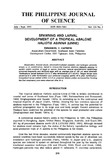Spawning and larval development of a tropical abalone Haliotis asinina (Linne)
Share
抄録
Dessication, thermal shock, ultraviolet-irradiated seawater, and hydrogen peroxide, singly or in combination, failed to induce the tropical abalone, Haliotis asinina to spawn viable number of eggs or sperm. However, natural spontaneous spawnings occurred frequently and fertilized eggs with an average size of 180 µm were obtained. Trochophore larvae hatched 5.2-5.6 h after fertilization (27.7-30.2°C). Veliger larvae were observed 8 h after fertilization and achieved creeping ability 30 h after fertilization. Competent larvae settled within 2-3 d on prepared diatom plates and juveniles forming the first respiratory pore were observed after 30 d.
Suggested Citation
Capinpin, E. C. (1995). Spawning and larval development of a tropical abalone Haliotis asinina (Linne). Philippine Journal of Science , 124(3), 215-232. http://hdl.handle.net/10862/1473
主題
Collections
- AQD Journal Articles [1240]


